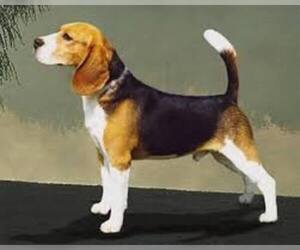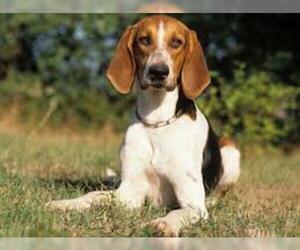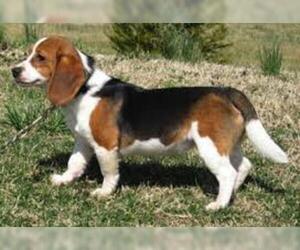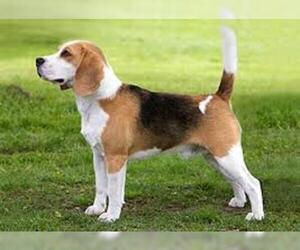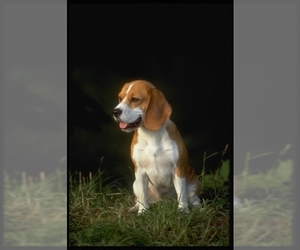
All about Beagle dog breed
A.K.A. :Gascogne-Beagle, Southern Hound, Dwarf Beagle, Pocket Beagle, Glove Beagle, English Beagle, Queen Elizabeth Pocket Beagle, Miniature Beagle, Toy Beagle, French Beagle, Harrier, Basset, Dachshund, Little Hound, Rabbit Hound, Hare Hound, Beag, Begs
Size
Grooming requirements
Exercise requirements
Good with other dogs
Watchdog ability
Energetic
Training requirements
Playful
Affectionate
Good with other pets
Good with children
Good with strangers
Winter
Summer
Healthiness
Protective
Life Span
| Pure Breeds | Member |
| Breeds A - Z | B |
| Breeds by Group | Hound Scenthound |
| Breeds by Trait | Good With Kids High Stamina Dog Breeds |
| Overview: | The Beagle is a beloved scent hound with a rich history, originally bred in England for hunting hare and rabbit. Their most recognizable physical traits include a sturdy, compact build, adorable floppy ears, and soulful brown or hazel eyes. Beagles typically weigh between 18-30 pounds and stand 13-16 inches tall, featuring a smooth, dense coat that comes in a variety of tri-color or bi-color patterns. In terms of temperament, they are known for being exceptionally friendly, curious, and outgoing, making them wonderful companions for families with children and other pets. However, their strong prey drive and inclination to follow interesting scents mean they require a securely fenced yard and consistent leash training. While adaptable, their need for exercise and tendency to vocalize (howl!) makes them less ideal for small apartment living unless daily walks and mental stimulation are guaranteed. Regarding health, Beagles can be prone to certain conditions like hip dysplasia, epilepsy, and intervertebral disc disease, making responsible breeding and regular veterinary check-ups important. |
F.A.Q.
All You Need to Know About the Beagle Breed
The Beagle, originating from England, is a beloved small hound renowned for its friendly, curious, and merry temperament. Physically, they possess a sturdy, muscular build, typically weighing 20-30 pounds, with distinctive long, droopy ears and an expressive, often pleading, gaze. Their short, dense coat, usually tricolor or bicolor, requires minimal grooming – a weekly brush suffices. Beagles are excellent family pets, incredibly good with children and other animals, making them a fantastic addition to most households. However, their strong prey drive and vocal nature (barking/howling) necessitate secure fencing and early training. While adaptable, apartment living can be challenging without ample daily exercise, as they are energetic and prone to mischief when bored. They require at least an hour of moderate activity daily, preferably off-leash in a safe area. Common health concerns include hip dysplasia, epilepsy, and ear infections, highlighting the importance of responsible breeding. Overall, a Beagle offers boundless affection and entertainment for the right owner.The average weight for an adult Beagle is between 20-30 pounds. Typically, male Beagles weigh 22-30 pounds, while female Beagles are slightly smaller, usually weighing 20-27 pounds. This is considered a healthy weight for a Beagle, ensuring they are not overweight or underweight for their breed standard.
Curious about Beagle height and their typical size? Here's what you need to know about how tall is a Beagle on average:
What is the average height of a Beagle in inches?
The average height of a Beagle typically ranges from 13 to 16 inches tall, measured at the shoulder (the highest point of their back, between the shoulder blades). This range encompasses both the "13-inch" and "15-inch" varieties of Beagles, which are official classifications based on their maximum height.While Beagles are generally a compact breed, you might notice some slight variations:- Gender: Male Beagles tend to be at the higher end of the range, often around 15-16 inches, while females might be slightly smaller, closer to 13-15 inches. However, this is not a strict rule, and individual genetics play a significant role.
- Individual Genetics: Just like people, individual Beagles can vary. Some may be a bit shorter or taller than the average, depending on their parentage and genetic makeup.
The Beagle breed comes in a variety of Beagle colors, officially recognized and rare. The AKC recognized Beagle colors predominantly include any true hound color, which translates to a wide range of bicolors and tricolors.Common and AKC-accepted Beagle colors include:* Tricolor: This is the most iconic, featuring black, white, and tan. Variations include Classic Tricolor (black saddle, tan points), Faded Tricolor (more muted black), and Dark Tricolor (deeper black and richer tan).* Bicolor: Often seen as lemon and white, red and white, or tan and white.* Single Color (very rare, usually White): While technically a single color, a truly all-white Beagle is exceedingly rare and usually categorized as "white and lemon" or "white and tan" if any cream or tan is present.Other accepted, but less common, Beagle colors within the "any true hound color" umbrella include:* Blue Tick/Mottled: A pattern of small, dark spots on a lighter background, typically black and white.* Red: A rich, solid reddish-brown.* Lemon: A very pale yellow or cream color, paired with white.* Tan: A light brown or fawn color, paired with white.* Brown/Liver: A chocolatey brown, often with lighter eyes and nose.* Black and Tan: No white present.Rare coat types and exotic Beagle variations (not accepted by major kennel clubs like the AKC and often indicative of mixed breeding or specific genetic mutations) include:* Merle: A patchy, diluted coat pattern not naturally occurring in purebred Beagles.* Blue: A dilute black, appearing grayish.* Lilac/Isabella: A dilute brown, appearing grayish-tan.* Chocolate: A rich, solid brown, distinct from the lighter "brown and white" often seen.* Brindle: Stripes of different colors, extremely rare in purebred Beagles.When considering Beagle colors, remember that AKC recognized Beagle colors adhere to specific breed standards, and rare coat types or exotic Beagle variations may impact eligibility for show, health, and pricing.
The Beagle personality is generally cheerful, friendly, and affectionate, making them wonderful family companions. Known for their loyalty, they form strong bonds with their human pack. These sociable dogs thrive on companionship and are usually good with respectful children, often enjoying playtime. Their pack mentality extends to other pets; Beagles typically get along well with other dogs and can adapt to living with cats if introduced properly. While adaptable, their vocal nature (baying) and need for mental stimulation (due to their strong scent drive) mean they may be better suited for homes where their unique characteristics are appreciated, though they can adapt to apartment living with sufficient exercise and engagement. The temperament of Beagle is curious, intelligent, and can be food-motivated, which aids in training, but their independent streak and love for following a scent can make them a bit stubborn at times.
The Beagle temperament is generally described as cheerful, friendly, and outgoing, making them excellent companion dogs. They are highly sociable and thrive on human interaction, showing great loyalty to their families. Beagles are typically good-natured with children, often exhibiting a playful and tolerant demeanor, though supervision is always advised with very young children. Their pack hound origins make them quite adaptable to living with other dogs, often enjoying their company. When it comes to other pets, particularly cats, early socialization is key, as their hunting instincts can sometimes surface, though many live harmoniously with feline companions.
While not ideal for extensive apartment living due to their need for regular exercise and a tendency to bay, they can adapt if their exercise requirements are consistently met. Beagles are intelligent but can be prone to stubbornness, especially when their nose is to the ground following an intriguing scent. This characteristic, coupled with their sensitivity to harsh correction, means positive reinforcement and patience are crucial for training. They are not known for being overly sensitive in general temperament but do respond best to gentle and consistent guidance. Overall, the Beagle's playful and affectionate personality traits make them beloved family members for those seeking a lively and devoted canine companion.Beagle Care: Essential Daily Maintenance for Your Companion
Caring for a Beagle involves understanding their specific needs. This active, charming breed thrives with proper attention to grooming, exercise, diet, and health. Here’s how to care for a Beagle:Grooming Needs: Beagles have a short, dense coat that requires minimal grooming. Weekly brushing with a rubber curry brush or a shedding blade helps remove loose hair and distribute natural oils, keeping their coat healthy. They shed moderately year-round, with heavier shedding in spring. Bathing is only necessary when they are visibly dirty or once every 1-2 months. Regular nail trimming (every 3-4 weeks) is crucial to prevent discomfort and foot problems. Pay special attention to their long, floppy ears. Weekly ear cleaning with a vet-approved solution is vital to prevent infections, as their ears can trap moisture and debris. Also, check for any skin issues during grooming.Exercise Limitations & Requirements: Despite their "low-energy dog breed" misconception on some sites, Beagles are energetic hounds that need significant daily exercise. They are not a low-energy breed. A minimum of 60-90 minutes of moderate to vigorous exercise daily is recommended. This can include brisk walks, jogging, playing fetch, or off-leash running in a securely fenced area. Due to their strong scent drive, Beagles should always be leashed when not in a secure, enclosed space to prevent them from wandering off. Mental stimulation through puzzle toys and scent games is also essential to keep their intelligent minds engaged and prevent boredom-induced destructive behaviors.Dietary Considerations & Weight Management: Beagles are highly food-motivated and prone to weight gain, making dietary control a primary concern. Feed a high-quality, age-appropriate dog food in measured portions twice daily. Avoid free-feeding. Monitor their calorie intake carefully and limit treats, especially high-calorie ones. Consult your veterinarian for specific dietary recommendations based on your Beagle’s age, activity level, and health status. Obesity can lead to serious health problems, including joint issues and heart disease.Wrinkle & Ear Cleaning: While Beagles don't have prominent wrinkles like Bulldogs, their floppy ears require diligent care. As mentioned, weekly ear cleaning is critical to prevent yeast and bacterial infections. Use a cotton ball or gauze with a veterinarian-recommended ear cleaner. Gently wipe the visible parts of the ear canal and around the ear flap. Never insert anything deep into the ear canal. If you notice redness, odor, or excessive scratching, consult your vet immediately. Regular dental care, including brushing their teeth several times a week, is also crucial to prevent dental disease, a common issue in Beagles.Climate Sensitivity & Brachycephalic Anatomy: Beagles, while not severely brachycephalic, have a somewhat compact skull structure compared to some breeds. This means they can be sensitive to extreme temperatures. They are prone to overheating in hot, humid weather and can suffer from hypothermia in very cold conditions. Always provide fresh water and shade in hot weather and limit strenuous exercise during peak heat. In cold weather, ensure they have a warm, dry place to sleep and consider a coat for outdoor excursions. Monitor their breathing during exercise; excessive panting or labored breathing can indicate distress.Common Health Concerns & Health Tips for Beagles: Beagles are generally healthy but are predisposed to certain conditions. Beyond weight management, skin issues such as allergies and ear infections are common. Regular vet check-ups are vital for early detection and prevention. Other concerns include dental disease, hip dysplasia, epilepsy, and hypothyroidism. Responsible breeding practices help reduce the incidence of genetic conditions. Maintaining a healthy weight, providing regular exercise, and consistent preventive care are the best health tips for Beagles to ensure a long and happy life.By following these guidelines for daily maintenance and understanding their specific needs, you can provide excellent Beagle care and enjoy many years with your beloved companion.The Beagle activity level is moderate. Beagles are known for their lively and inquisitive nature, typically exhibiting short bursts of energy followed by long periods of rest. Despite their smaller size, they are how active are Beagle and require consistent daily exercise to prevent boredom and maintain a healthy weight.A Beagle needs at least 60 minutes of dedicated exercise daily, ideally broken into a few sessions. This can include brisk walks, playtime in a securely fenced yard, or engaging in scent-work games that appeal to their strong hunting instincts. They thrive on activities that stimulate both their bodies and minds. While they enjoy active play, it's crucial to be mindful of their brachycephalic (short-nosed) anatomy. Over-exertion, especially in warm or humid weather, can lead to respiratory distress. Therefore, intense, prolonged running is not recommended.Beagles are suitable for active families who enjoy regular outdoor activities and can provide consistent engagement. While they can adapt to low-energy households, those families must still commit to meeting their substantial exercise needs through dedicated walks and playtime, even if the family itself isn't constantly on the go. They love to sniff and explore, making walks a highlight of their day. They are not a "couch potato" breed that will be content with minimal activity; insufficient exercise can lead to destructive behaviors like excessive barking or chewing.
Breed Breakdown: What Experts Say About the Beagle
I would rate the Beagle's "Size" trait as a 4.Beagles are undeniably a small-to-medium sized breed. Their average height typically ranges from 13 to 15 inches at the shoulder, and they generally weigh between 20 to 30 pounds. Their body structure is compact and sturdy, built for endurance rather than imposing stature. Compared to other companion dogs, they are significantly larger than toy breeds like Chihuahuas (1-2) but considerably smaller than large breeds such as Golden Retrievers or Labradors (7-8) and certainly giant breeds like Great Danes (10). They fall squarely into the small end of the medium spectrum.This size makes Beagles generally well-suited for apartment living, provided they receive sufficient daily exercise. Their compact nature also makes them quite adaptable for travel, fitting comfortably in crates or carrier bags designed for their size. For households with space constraints, they are a good option as they don't demand a vast amount of physical space indoors, though their need for outdoor activity remains high.
I would rate the Beagle's grooming requirements as a 3.Beagles are relatively low-maintenance when it comes to grooming. Their short, dense coat sheds moderately year-round, but it doesn't typically mat or tangle, making brushing a quick and easy task a few times a week. They don't have extensive skin folds that require specialized care. Their floppy ears do need regular cleaning to prevent infections due to their design, and nail trimming is essential like with all dogs. While they can be prone to allergies, which might manifest as skin issues requiring veterinary attention, this isn't a direct grooming requirement but rather a potential health concern. Overall, compared to many other companion dogs with long, curly, or double coats, Beagles are quite easy to care for and don't demand frequent, specialized grooming beyond basic hygiene.
I'd rate the Beagle's "Exercise Requirements" at a 7 out of 10.Beagles are deceptively energetic dogs, bred for stamina and scent work, which means they are not content to be couch potatoes. While they might appear to be small, they possess a significant amount of energy that needs to be channeled appropriately. They thrive on daily, structured exercise, not just a quick stroll around the block. A minimum of 60-90 minutes of vigorous activity spread throughout the day is ideal, often in the form of brisk walks (allowing plenty of time for sniffing), off-leash playtime in a secure area, or even short bursts of running. Their brachycephalic (short-nosed) anatomy does present some respiratory limitations, particularly in hot and humid weather, meaning exercise needs to be monitored to prevent overheating and overexertion. However, with careful management, they are generally well-suited for various activities, including some agility and scent work, which not only provides physical exercise but also essential mental stimulation. Without sufficient physical and mental outlets, Beagles can become bored, destructive, and prone to weight gain, making consistent exercise crucial for their overall health and well-being. They absolutely require a structured routine to stay healthy and mentally stimulated, rather than thriving on minimal activity.
I'd rate the Beagle's "Watchdog Ability" at a 4.Beagles are incredibly friendly and, while they do have a distinct and loud bay that they use for tracking, they're not particularly inclined to be protective or territorial. Their barking is more often a form of communication (e.g., "I smell something interesting!" or "I'm bored!") rather than an alert to a perceived threat. They are generally quite sociable and might even greet an unfamiliar person with a wagging tail rather than suspicion. While their initial bark might make you aware of someone approaching, their natural inclination is more towards a friendly investigation than a deterrent. They are more of a passive companion who might offer an early *sound* warning of an arrival, but not a meaningful *deterrent* to an intruder.
I would rate the "Good with Other Dogs" trait of the Beagle breed a 9 out of 10.Beagles are generally extremely sociable and dog-friendly. Their pack-hunting origins have ingrained in them a natural inclination to enjoy canine company. They typically exhibit a friendly curiosity towards unfamiliar dogs, rather than aggression or shyness, and are often eager to engage in play. Their sturdy build and playful nature make them adaptable to dogs of various sizes and energy levels, from boisterous Labs to more sedate companions, as long as the other dog is also amenable to interaction. While early socialization is always beneficial for any dog, Beagles tend to pick up on appropriate dog-to-dog etiquette with relative ease. They thrive in multi-dog households and often display a cooperative, rather than dominant or aggressive, demeanor within a pack setting. Any potential for conflict usually arises from their prey drive being triggered by very small, fast-moving dogs (which is not necessarily aggression towards the dog itself, but rather an instinctual response) or a lack of proper human guidance. For the most part, Beagles are exceptionally good-natured and enjoy the companionship of other canines, readily forming bonds and seeking out playful interactions.
I would rate the Beagle's "Energetic" trait a 7 out of 10.Beagles are undeniably active and lively dogs. They possess a surprising amount of stamina and a high typical activity level, driven by their history as scent hounds. Their playfulness is legendary, and they require a significant amount of physical stimulation to keep them content and prevent boredom-induced behaviors. They love to run, chase, and explore, making them excellent companions for outdoor activities like hiking and long walks. Compared to many other companion breeds, they are naturally active and far from laid-back, thriving on consistent exercise.However, their brachycephalic anatomy, while not as pronounced as some other breeds, does play a role in their overall exercise tolerance. While they have good endurance for their size, prolonged, intense exercise in hot or humid weather can be challenging and potentially dangerous due to their shorter snouts and less efficient cooling systems. They can become overheated more easily than a dolichocephalic breed with similar energy levels. Therefore, while they are very energetic and require substantial activity, their physical limits, particularly in certain conditions, prevent them from reaching a 9 or 10, which would be reserved for breeds with virtually limitless energy and no anatomical constraints on their stamina.
I would rate the training requirements of a Beagle at a 7.While Beagles possess a decent level of intelligence, their famously stubborn nature and powerful scent drive make them a significant challenge to train, moving them far from the "very easy" end of the spectrum. Their attention span can be fleeting, especially when an intriguing smell captures their focus, making sustained responsiveness to commands difficult. Consistent, patient, and engaging training is absolutely crucial, as they can easily become bored or simply decide they'd rather follow their nose than your instructions. Positive reinforcement is highly effective – they are very food-motivated, which can be a valuable tool, but even then, their independent streak often shines through. This breed is not beginner-friendly when it comes to training. They truly benefit from experienced handling, a structured routine, and a owner prepared to put in considerable time and effort to build a strong foundation and manage their innate desires.
I would rate the Beagle's "Playful" trait an 8 out of 10.Beagles are undeniably spirited and possess a natural zest for life. They are far from laid-back, especially when young. Their typical activity level is high, requiring regular exercise and mental stimulation to prevent boredom. They absolutely love games, particularly those involving their keen sense of smell, like hide-and-seek with treats or scent work. Their attention-seeking behavior manifests in their vocalizations – those characteristic "baying" sounds – and their persistent nudges for interaction. They respond to toys and playtime with immense enthusiasm, often getting fully absorbed in a game of fetch or a tug-of-war. This overall enthusiasm carries over into their daily lives, making them engaging and often comical companions. While they aren't quite the perpetual motion machines of, say, a Jack Russell, their innate curiosity, joyful disposition, and love for interaction solidify their position as a highly playful breed.
I'd rate the "Affectionate" trait of the Beagle breed at a strong 9 out of 10.Beagles are renowned for their loving and people-oriented nature. They have an almost insatiable desire for human companionship and are often described as "velcro dogs" due to their tendency to follow their owners from room to room. Physical closeness is a high priority for them; they are typically eager cuddlers and lap-sitters, always seeking out a warm spot next to their beloved humans. Their loyalty is unwavering, and they form deep bonds with their families. Furthermore, Beagles can be surprisingly sensitive to owner emotions, sometimes mirroring moods or offering comfort. This breed truly thrives on affection and feels most secure and happy when integrated into family life. While they possess a certain independent spirit when following a scent, this rarely translates to emotional distance from their people; rather, their independence is more about their hunting instinct. Compared to more aloof breeds, Beagles are overwhelmingly affectionate and desire constant interaction.
I would rate the Beagle's "Good with Other Pets" trait as a 7 out of 10.Beagles are generally quite amiable and social dogs, making them relatively good candidates for multi-pet households. Their pack instinct, developed over generations of hunting in groups, often translates into a desire for companionship, whether human or animal. This means they tend to be naturally sociable with other dogs, often enjoying play and the presence of canine companions.However, their strong prey drive, a hallmark of their scenthound heritage, can be a significant factor when it comes to smaller, non-canine pets like cats, rabbits, or birds. While many Beagles can learn to coexist peacefully with cats, especially if introduced at a young age and raised together, their instinct to chase can be powerful. This requires careful and consistent training, supervision, and often a secure separation strategy when unsupervised, especially with very small or timid cats. Without this, a cat might be seen as quarry rather than a housemate. Resource guarding is generally not a prominent trait in Beagles compared to some other breeds, but it can still emerge in individual dogs and is best addressed through early training and management.Overall, a Beagle's adaptability and generally good nature mean they have high potential to be extremely pet-friendly, but successfully integrating them into a multi-pet home, particularly with non-canine animals, often requires dedicated socialization, consistent training, and ongoing supervision to manage their natural instincts and ensure peaceful coexistence. They are not typically a breed that can be entirely unsupervised with all other types of pets from the outset, but with effort, they can become wonderful companions for a diverse animal family.
I'd rate the Beagle's "Good with Children" trait a strong 8 out of 10.Beagles are generally a fantastic choice for families with children. Their temperament is naturally cheerful, affectionate, and incredibly tolerant, which are all crucial qualities for a household with kids. They possess a playful spirit that matches a child's energy, making them excellent companions for games in the yard. Their patience is noteworthy; they tend to be forgiving of accidental tugs or the sometimes-clumsy handling that comes with young children, and their tolerance for noise is generally high given their hunting background where they are exposed to various sounds. They thrive on companionship and are rarely aggressive, preferring to join in the fun. While naturally gentle and affectionate, like any breed, early socialization and consistent, positive reinforcement training are always beneficial to ensure they integrate seamlessly into a family setting and understand boundaries, but they typically don't *require* extensive behavior modification to be good with kids – it's more about refining their natural tendencies. Supervision is always recommended with any dog and very young children, but Beagles are inherently well-disposed to being around children of various ages.
I would rate the Beagle's "Good with Strangers" trait a 9 out of 10.Beagles are renowned for their generally amiable and outgoing nature, making them highly sociable with unfamiliar adults. They typically display a friendly curiosity rather than apprehension, often eager to investigate a new person with a wagging tail and a hopeful sniff for treats or attention. While they might bark initially out of excitement or to announce a new presence, this is rarely accompanied by aggression or a guarding instinct; rather, it's often a "hello, who are you?" kind of greeting. Their innate friendliness means they are naturally outgoing and generally do not require extensive training to be comfortable with strangers. In fact, their biggest challenge in public or guest-filled environments is often managing their enthusiasm and preventing them from following every interesting scent or person.
The Beagle breed generally rates a 3 for "Winter" tolerance.Beagles possess a short, dense coat that offers some protection, but it's not thick enough to withstand prolonged exposure to very cold temperatures. Their moderate body fat provides limited insulation, and their small to medium size means they lose heat more quickly than larger breeds. Critically, while not severely brachycephalic, their snouts are not long enough to warm incoming air sufficiently in very cold conditions, which can lead to respiratory irritation. They are susceptible to hypothermia, especially in wet or windy conditions, and their enthusiasm for scent tracking can sometimes override their sense of self-preservation, leading them to stay out longer than is safe.Compared to many other companion dogs, Beagles definitely require special care during winter months. They are not built for harsh winter conditions and are at a higher risk of cold-related illnesses. They need a warm indoor environment, and outdoor time in cold climates should be brief and supervised. Sweaters or coats are highly recommended for walks, and their paws should be protected from ice and salt. They are not a breed that can be left outside for extended periods in winter, even with a doghouse, as their natural insulation is insufficient.
I would rate the Beagle's "Summer" tolerance as a 4.Beagles are not inherently built for extreme heat, placing them on the lower end of moderate tolerance. While not as severely brachycephalic as Pugs or Bulldogs, their slightly longer snouts still offer less efficient cooling than breeds with very long muzzles. Their dense, double coat, while short, is designed for warmth and can trap heat, making it harder for them to regulate body temperature effectively. This puts them at a noticeable risk of heatstroke, especially during prolonged or strenuous activity in hot and humid conditions. During summer months, their outdoor activity levels need significant modification; walks should be limited to early mornings or late evenings when temperatures are cooler, and vigorous exercise should be avoided altogether. They absolutely require climate control during hot weather, meaning access to air conditioning or fans indoors. Compared to many other companion dogs with single coats or longer snouts, Beagles require special care in summer months to prevent overheating and ensure their well-being.
I would rate the Beagle's "Healthiness" trait as a 7 out of 10.Beagles are generally considered a robust breed compared to many other companion dogs. They are not prone to the extreme conformational issues that lead to severe breathing difficulties or joint problems seen in some brachycephalic or giant breeds. Their life expectancy is respectable, typically ranging from 12 to 15 years. However, they are not without their specific health considerations. Genetic predispositions exist for conditions such as epilepsy, hip dysplasia (though less prevalent than in larger breeds), hypothyroidism, and eye conditions like glaucoma and cherry eye. They can also be prone to ear infections due to their long, floppy ears and are notorious for their food drive, which can easily lead to obesity if not managed, contributing to other health problems. Responsible breeding significantly impacts the reduction of these genetic issues, and a good diet combined with regular exercise and preventive veterinary care helps them thrive. While not exceptionally high-maintenance in terms of health, owners do need to be vigilant about diet and ear care, and aware of potential genetic predispositions.
I would rate the "Protective" trait of the Beagle breed as a 3 out of 10.Beagles are generally not considered protective dogs. While they are very alert and will bark at the sound of strangers approaching, their territorial instincts are low, and their reaction to new people is typically one of curiosity and friendliness rather than aggression or suspicion. Their overwhelming desire to please and their gentle nature make them poor candidates for guard dog duties. They are incredibly loyal to their owners but express that loyalty through companionship and affection, not through a protective stance against perceived threats. Ultimately, Beagles are primarily companion dogs, excelling in being loving, active family members. They might alert you to an intruder with their distinctive bay, but they are far more likely to greet the stranger with a wagging tail than to offer any meaningful physical protection in a household setting.
I'd rate the Beagle's "Life Span" trait a 7.Beagles are generally considered a long-lived breed compared to many other companion dogs, with an average life expectancy typically ranging from 10 to 15 years, and often closer to the higher end with good care. While they are prone to certain health issues like hip dysplasia, epilepsy, and eye conditions, these are not usually life-limiting in the same way some breed-specific cancers or severe organ failures can be for other breeds. Responsible breeding practices help mitigate some genetic predispositions, and their generally robust nature, combined with a good diet, regular exercise, and preventative veterinary care, contributes significantly to their extended lifespan. They don't typically fall into the "very long-lived" category like some tiny breeds, nor are they considered "short-lived."
Beagle Puppies for saleSee all puppies for sale
Beagle Dogs for adoptionSee all dogs for adoption
Beagle BreedersSee all breeders
Similar Dog Breeds for Beagle
Breed Mixes of Beagle
Quick Breed Selector 0 - not important, 1 - smallest, 10 - largest
Variants & Mistakes :Bagel, Begal, Beagel, Beegle, Begele, Begle, Beegel, Beaglee, Beagal, Beggel, Beagke, Beaagle, Beagele, Beaggle, Begale, Begall, Beagk, Beage, Beegl, Begel, Beeagle, Beagl, Beaglke, Beaglqe, Beaglwe, Beaglre, Beaglte, Beagly, Beaglu, Beagli, Beaglo, Beaglp
